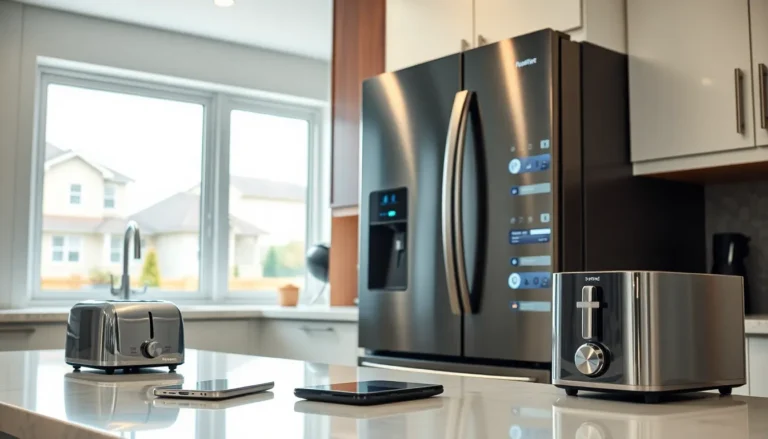Table of Contents
ToggleIn a world where your fridge can remind you to buy milk and your thermostat knows when you’re home, the Internet of Things (IoT) isn’t just a tech buzzword—it’s a game changer. As businesses scramble to hop on this digital bandwagon, the right IoT implementation can transform operations from mundane to miraculous. Imagine a workplace where everything communicates seamlessly, making life easier and saving time—sounds like a sci-fi dream, right?
Overview of IoT Implementation
The Internet of Things (IoT) revolutionizes how devices communicate and interact. Understanding its implementation provides insights into its potential benefits.
Definition of IoT
IoT refers to the network of interconnected devices that share data through the internet. This technology includes smart devices, sensors, and software that work together seamlessly. By leveraging advanced connectivity, these devices facilitate real-time data analysis and enhance user experiences. Common examples include smart home devices, wearables, and industrial machinery. Enhancing their functionalities, IoT enables automation and remote control, thereby creating a smarter environment.
Importance of IoT Implementation
Implementing IoT technology significantly boosts efficiency across various sectors. Organizations gain insights into operational processes, which leads to informed decision-making. Industries such as healthcare benefit from improved patient monitoring, while manufacturing sees reduced downtime through predictive maintenance. In addition, energy management systems optimize consumption and reduce costs. Moreover, smart transportation systems enhance traffic efficiency, contributing to sustainability efforts. Prioritizing IoT implementation fosters innovation and drives competitive advantage in the market.
Key Components of IoT Implementation

The successful implementation of IoT relies on three key components: sensors and devices, connectivity and networking, and data processing and analytics. Understanding these components enables organizations to maximize their IoT potential.
Sensors and Devices
Sensors and devices form the backbone of IoT. They collect real-time data from the environment, feeding valuable information into the network. Various types of sensors, including temperature, motion, and pressure sensors, play essential roles across applications. Smart devices, like connected appliances and industrial machines, enhance user interactions through automation. Integration of these technologies significantly boosts operational efficiency, making it easier to monitor processes in sectors such as healthcare and manufacturing.
Connectivity and Networking
Connectivity and networking serve as the lifeline for IoT systems. Different communication protocols, like Wi-Fi, Bluetooth, and cellular networks, support the seamless exchange of data. This ecosystem relies on both short-range and long-range connectivity, ensuring devices remain linked and functional. Cloud services often amplify this connectivity, allowing centralized data storage and accessibility. An effective network design reduces latency and enhances data transmission speed, promoting robust real-time decision-making.
Data Processing and Analytics
Data processing and analytics transform raw information into actionable insights. Advanced analytics tools enable organizations to derive meaning from vast amounts of data collected by devices. Real-time processing streamlines operations, while machine learning algorithms identify patterns and enhance predictive capabilities. By implementing robust analytics frameworks, organizations can optimize resource allocation and improve overall performance. Utilizing insights gained from data analysis empowers businesses to innovate and stay competitive in a continuously evolving marketplace.
Challenges in IoT Implementation
Implementing IoT comes with several challenges that organizations must navigate. Technical barriers and security concerns frequently hinder effective deployment.
Technical Barriers
Technical barriers arise from interoperability issues among devices. Many devices use different protocols, complicating seamless communication. Limited bandwidth can also affect data transmission, especially in high-density environments. Additionally, scaling the infrastructure often proves difficult. Organizations may face complexities in integrating new devices with existing systems. Adequate knowledge and skilled personnel are necessary to tackle these technical challenges effectively. Every step in development and deployment requires comprehensive planning to prevent delays.
Security Concerns
Security concerns represent a significant hurdle in IoT implementation. The growing number of connected devices increases the potential attack surface for cyber threats. Vulnerabilities in IoT devices often stem from outdated software or insufficient encryption methods. Breaches can lead to unauthorized access, putting sensitive data at severe risk. Moreover, securing data in transit and at rest remains a challenge, as data flows through multiple networks. To mitigate risks, organizations must prioritize robust security measures, implementing regular updates and employing advanced authentication protocols. Careful consideration of security can minimize risks and build trust in IoT ecosystems.
Case Studies of Successful IoT Implementation
Successful IoT implementation illustrates its transformative potential across various sectors. Case studies highlight how smart technologies drive efficiency and innovation.
Smart Cities
Smart city initiatives utilize IoT to enhance urban living. Sensors integrated into traffic lights and public transport optimize congestion by managing real-time data. Cities like Barcelona employ smart waste management systems, reducing costs through efficient collection schedules. Energy-efficient streetlights automatically adjust brightness based on pedestrian activity, conserving energy and improving safety. Connectivity between devices facilitates better resource management, directly impacting citizen quality of life. Data analytics provides municipalities with actionable insights to foster sustainability and respond effectively to urban challenges.
Industrial IoT
Industrial IoT transforms manufacturing processes through enhanced automation. Companies like General Electric leverage connected machines to monitor performance and predict maintenance needs. This predictive maintenance significantly reduces downtime, boosting productivity and lowering operational costs. Real-time data analysis improves supply chain efficiency by tracking inventory levels and optimizing logistics. Furthermore, connected devices enable remote monitoring, allowing technicians to troubleshoot issues without on-site visits. By integrating IoT solutions, industries adapt quicker to market demands, reinforcing their competitive edge and driving innovation.
Future Trends in IoT Implementation
IoT implementation continues to evolve rapidly, driven by technological advancements and shifting market demands. Organizations must anticipate these trends to maximize their competitive edge.
Emerging Technologies
Edge computing plays a significant role in enhancing IoT efficiency. This technology processes data closer to the data source, reducing latency and bandwidth strain. Artificial intelligence integrates seamlessly into IoT systems, enabling predictive analytics and smarter decision-making. Blockchain technology emerges as a strong contender, enhancing security and trust through decentralized data management. Additional innovations, such as 5G connectivity, provide high-speed communication, facilitating the real-time exchange of vast data volumes. These emerging technologies collectively pave the way for more sophisticated and reliable IoT systems.
Predictions for IoT Growth
Analysts project that the global IoT market could reach $1.1 trillion by 2026, with a compound annual growth rate of 24.9% from 2021 to 2026. Healthcare and manufacturing sectors particularly exhibit strong growth potential, leveraging IoT for improved patient monitoring and predictive maintenance. Increased adoption of smart home devices, expected to reach 500 million units by 2025, signals a shift toward more automated living environments. Furthermore, efforts to enhance cybersecurity protocols around IoT devices will likely gain momentum, addressing significant security concerns. These factors indicate a robust landscape for IoT expansion, emphasizing the need for strategic implementation among organizations.
Embracing IoT implementation is no longer a choice but a necessity for organizations aiming to thrive in a competitive landscape. The benefits of enhanced efficiency and improved decision-making are undeniable. As industries evolve with emerging technologies like edge computing and artificial intelligence, the potential for IoT to drive innovation continues to expand.
Organizations that prioritize strategic planning and robust security measures can effectively navigate the challenges associated with IoT deployment. By doing so, they not only optimize operations but also enhance user experiences across various sectors. The future of IoT is bright, and those who adapt will undoubtedly lead the way in transforming everyday life and business practices.





